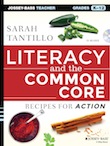Sarah Tweaks Her Socratic Seminar Recipe
Sarah Tantillo extends her wildly popular 2013 MiddleWeb post, Socratic Seminars in the Middle, with a variation suggested by middle school social studies teacher Jamison Fort. Thanks to Sarah for continuing to share her many useful resource documents with our readers and to Jamison for his add-ons! UPDATE: Also see this 2023 post about Socratic Seminars: Rewiring Student Brains for Class Discussions.

Socratic Seminars are one terrific method for training students in how to conduct intelligent conversations. Students learn how to use effective habits of discussion, explain their ideas, and support them with evidence (Take THAT, Common Core Standards!). Different educators have different ways of conducting Socratic Seminars.
In fact, since I first wrote here about this topic in 2013, a colleague suggested an improvement that I want to share here today, along with video clips of his students engaged in an actual seminar and debrief session.
First, here is my original recipe. I have made available for free all of the resource documents found at The Literacy Cookbook “Socratic Seminars” page, where you’ll find my latest information about this excellent teaching strategy.
- Direct four students to sit in the middle of the room, circled by the rest of the class. Everyone in the class has read the same text (story, article, editorial, chapter…) or undergone the same experience (such as a field trip or science lab); these four are responsible for discussing a given set of questions about it for a given amount of time (I recommend 10 minutes). NOTE: They are the only ones who speak; even you will not say a word once the discussion has begun. Related documents: Socratic Seminar Questions on Persuasive Texts and Socratic Seminar Questions on Short Stories. Also, consider adapting questions from the Book Talk Project for Class Novel; each group can discuss a different chapter.
At the same time, select four others in the outside circle to observe the four participants; the observers will complete a checklist and give feedback on their designated participant’s performance. Related document: Socratic Seminar Observation Checklist.
- Everyone else in the class takes guided notes on the discussion. (NOTE: Sample questions for guided notes are included in the downloads Socratic Seminar Questions on Persuasive Texts and Socratic Seminar Questions on Short Stories.)
- Use a detailed rubric to score each of the discussants. See the Socratic Seminar Rubric.
- After the discussion, invite the observers to share a few positive comments, then provide your own specific constructive feedback so that everyone in the room will learn more about how to do well.
- Lather, rinse, repeat. Rotate the participants. Although you probably won’t have time in one class period for every student to experience every different role, assure them that eventually they will all have numerous chances to discuss in the middle, be an observer, and take notes. NOTE: Plan ahead! Having a well-organized grade-recording system will make your life easier.
(For more tips and details, see my first MiddleWeb article, Socratic Seminars in the Middle.)
A good tweak of my Socratic Seminar recipe
Recently my friend Jamison Fort, who teaches 6th grade Social Studies at Maxson Middle School in Plainfield, NJ, tried out my recipe and then tweaked it to make it even tastier. Specifically, he changed the dynamics in the inner circle by changing how the participants were scored. Jamison says he realized two things:
► The more dominant students in the class were most focused on getting their thoughts heard, rather than having a balanced conversation. Even after receiving feedback and making improvements, the conversations were still uneven.
► Students spent a lot of time discussing their opinions.
“So I adjusted the expectations of the Seminar,” explains Jamison. “I turned it into a competition where the students talking were now on teams. Each student could only gain four points, and those points were only gained when a student made a statement and clearly supported it with evidence from the texts. This motivated them to have a balanced, evidence-based discussion.”
The team-based scoring sheet he used is here. And here is video footage of his students in action.
First, the discussion…
Then the debrief…
Here is more context for their Seminar:
Topic: “Should parents burn their children’s textbooks?”
Texts discussed: Textbook burning in Venezuela and Venezuela’s New Textbooks Glorify Hugo Chavez
Students in the middle: Karen, Davie, Tajian, and Bryan.
Allotted time for discussion: The center group was given 4 minutes for their discussion.
Allotted time for debrief: The observers in the outer circle are given about three minutes to offer feedback on the discussion and individual students’ performance.
Audience role: Student audience members listen to the discussion and use a score sheet to keep track of the points made and supported with textual evidence (a point made without evidence did not count).
Key Support Documents
- Socratic Seminar Observation Checklist
- Socratic Seminar Questions on Persuasive Texts
- Socratic Seminar Questions on Short Stories
- Socratic Seminar Rubric
- Book Talk Project for Class Novel
- Habits of Discussion 1-pager
- TO KILL A MOCKINGBIRD Socratic Seminar Questions
- Socratic Seminar Team Scoring Sheet
- Various Socratic Seminar Tools
Source: Socratic Seminars, The Literacy Cookbook website
Note: Sarah’s original entry was adapted from a chapter in The Literacy Cookbook, which can be ordered here.

Cover image credit.



































This discussion structure works equally well across all content areas and grade levels, while addressing numerous Common Core standards. Our teachers easily adopted Sarah’s user-friendly strategies and resources, and were very excited about their students’ enthusiastic participation. Kudos to Jamison for taking it a step further!
I usually have 6-8 students in the center while they discuss the text. I also simply jot down a code on my roster each time they contribute to a conversation(L=leadership, Q=Question, R= Response etc.). I also can make notes when they are on the outside of the circle. This alleviates the paper of another rubric, and I can also make notes about key points. Then I add up how many of these they had to score them. I do like the idea of noting the depth of insight to the list of criteria. (I teach High School, by the way.)
Great. Thanks for sharing.